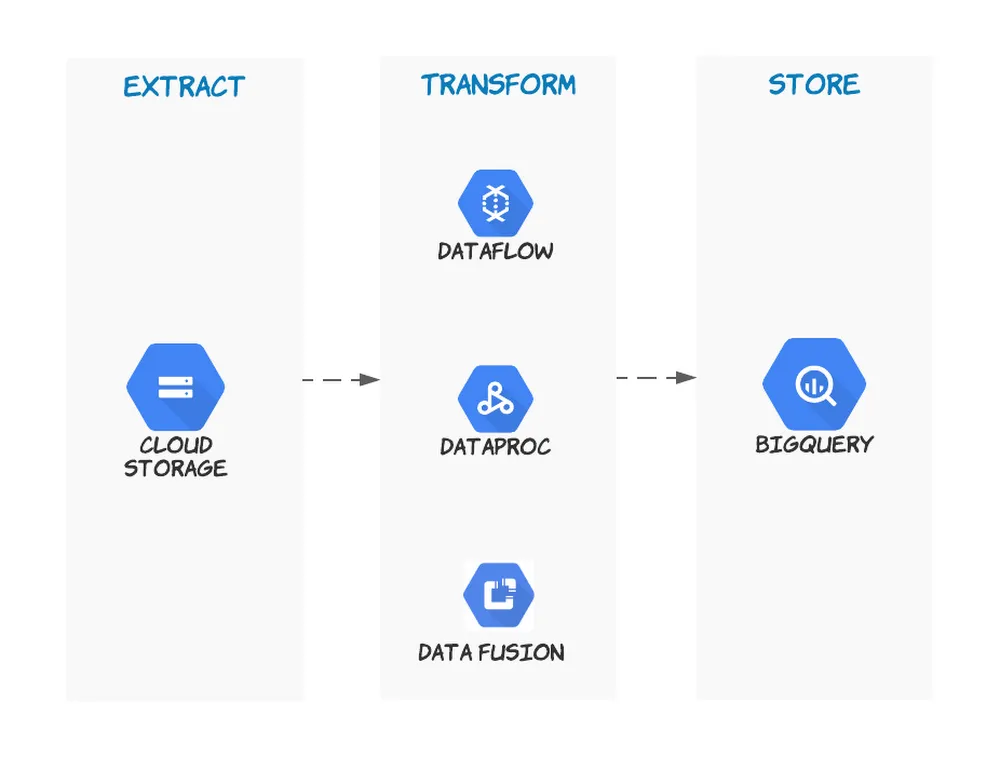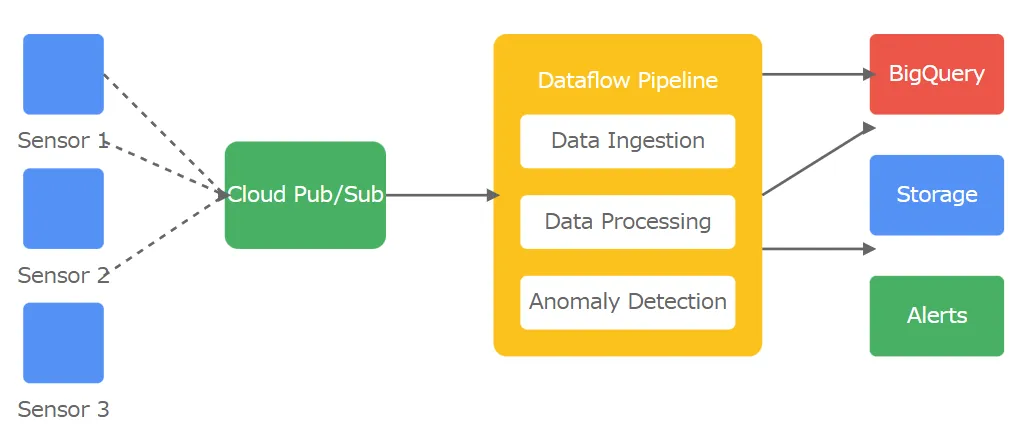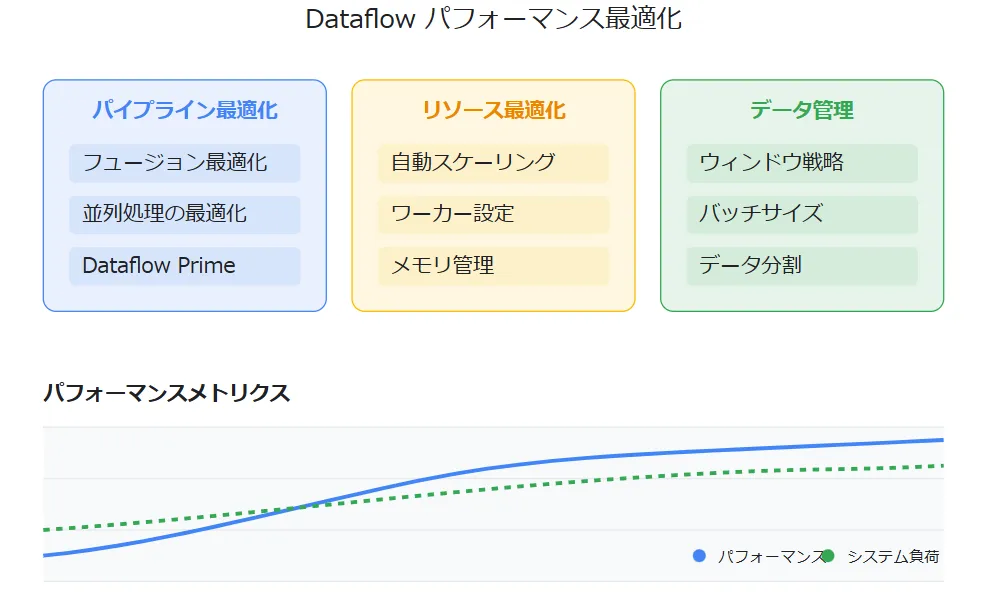· データ処理とワークフロー · 4 min read
Cloud Dataflow を使った ETL パイプラインの構築:実践ガイド
Google Cloud Dataflow を使用して効率的な ETL パイプラインを構築する方法を詳しく解説します

Cloud Dataflow による ETL 処理の現在位置
ETL パイプラインの実装方法は、この数年で大きく進化しています。特に Google Cloud の Dataflow は、以下の特徴により企業の ETL 処理の中心的な役割を担っています:
- サーバーレスで運用負荷を最小化
- Dataflow Prime による自動最適化
- ストリーミングとバッチの統合処理
- BigQuery や Pub/Sub との緊密な連携
- フルマネージドな監視と運用

実践的なユースケース
1. ログ分析パイプライン
複数のアプリケーションからのログを収集し、分析可能な形式に変換する例:
import apache_beam as beam
from apache_beam.options.pipeline_options import PipelineOptions
class LogParsingTransform(beam.DoFn):
def process(self, element):
try:
# タイムスタンプ、ログレベル、メッセージの抽出
parsed = json.loads(element)
yield {
'timestamp': parsed['timestamp'],
'level': parsed['level'],
'service': parsed['service'],
'message': parsed['message'],
'attributes': parsed.get('attributes', {})
}
except Exception as e:
yield beam.pvalue.TaggedOutput('parsing_error', {
'raw_message': element,
'error': str(e)
})
def run_pipeline():
options = PipelineOptions()
with beam.Pipeline(options=options) as p:
# Pub/Sub からログを読み込み
logs = (p
| 'ReadLogs' >> beam.io.ReadFromPubSub(topic='projects/my-project/topics/logs')
| 'ParseLogs' >> beam.ParDo(LogParsingTransform())
| 'WindowByMinute' >> beam.WindowInto(window.FixedWindows(60))
)
# エラーログの検出と通知
error_logs = (logs
| 'FilterErrors' >> beam.Filter(lambda x: x['level'] == 'ERROR')
| 'CreateAlerts' >> beam.ParDo(AlertGenerationFn())
)
# 集計とBigQueryへの書き込み
(logs
| 'AggregateByService' >> beam.GroupByKey('service')
| 'WriteToBQ' >> beam.io.WriteToBigQuery(
'project:dataset.logs_summary',
schema=schema,
write_disposition=beam.io.BigQueryDisposition.WRITE_APPEND
)
)
2. IoT データ処理パイプライン
センサーデータのリアルタイム処理と異常検知:

class SensorDataTransform(beam.DoFn):
def setup(self):
# ML モデルの初期化
self.model = self.load_anomaly_detection_model()
def process(self, element):
# センサーデータの正規化
normalized = self.normalize_data(element)
# 異常検知
if self.detect_anomaly(normalized):
yield beam.pvalue.TaggedOutput('anomalies', normalized)
yield normalized
def create_iot_pipeline(p, options):
# センサーデータの読み込み
raw_data = (p
| 'ReadSensorData' >> beam.io.ReadFromPubSub(topic=options.input_topic)
| 'ParseJSON' >> beam.Map(json.loads)
)
# データ処理とウィンドウ化
processed_data = (raw_data
| 'ProcessSensorData' >> beam.ParDo(SensorDataTransform())
| 'WindowData' >> beam.WindowInto(
window.SlidingWindows(
size=60, # 60秒のウィンドウ
period=5 # 5秒ごとにスライド
))
)
3. データウェアハウス更新パイプライン
複数ソースからのデータを統合し、データウェアハウスを更新:
class DataWarehouseUpdatePipeline:
def __init__(self, options):
self.options = options
def create_pipeline(self):
p = beam.Pipeline(options=self.options)
# CRM データの読み込みと変換
crm_data = (p
| 'ReadCRM' >> beam.io.ReadFromAvro(self.options.crm_input)
| 'TransformCRM' >> beam.ParDo(CRMTransform())
)
# 販売データの読み込みと変換
sales_data = (p
| 'ReadSales' >> beam.io.ReadFromParquet(self.options.sales_input)
| 'TransformSales' >> beam.ParDo(SalesTransform())
)
# データの結合
merged_data = ((crm_data, sales_data)
| 'MergeData' >> beam.CoGroupByKey()
| 'CreateDWRecord' >> beam.ParDo(DWRecordCreate())
)
return p
実装のベストプラクティス
テスト可能な設計
パイプラインのコンポーネントを独立してテスト可能に設計:
class DataTransform(beam.PTransform):
def expand(self, pcoll):
return (pcoll
| 'Clean' >> beam.ParDo(DataCleaningFn())
| 'Validate' >> beam.ParDo(DataValidationFn())
| 'Transform' >> beam.ParDo(BusinessLogicFn())
)
# ユニットテスト
def test_data_transform():
with TestPipeline() as p:
input_data = [{'id': '1', 'raw_value': ' 100 '}]
output = (p
| beam.Create(input_data)
| DataTransform()
)
assert_that(output, equal_to([{'id': '1', 'value': 100}]))
エラー処理とリカバリ
堅牢なエラー処理とリカバリメカニズム:
class RobustTransform(beam.DoFn):
def setup(self):
self.retries = Metrics.counter('main', 'retry_count')
@retry.with_exponential_backoff(
num_retries=3,
initial_delay_secs=1
)
def process_with_retry(self, element):
try:
result = self.transform_data(element)
return result
except TransientError as e:
self.retries.inc()
raise
except PermanentError as e:
yield beam.pvalue.TaggedOutput('permanent_errors', {
'element': element,
'error': str(e)
})
パフォーマンス最適化
Dataflow Prime を活用した最適化設定:

pipeline_options = PipelineOptions()
pipeline_options.view_as(DebugOptions).experiments = [
'use_runner_v2',
'prime_transform_support',
'enable_streaming_engine'
]
pipeline_options.view_as(WorkerOptions).max_num_workers = 100
pipeline_options.view_as(WorkerOptions).autoscaling_algorithm = 'THROUGHPUT_BASED'
運用とモニタリング
メトリクスの可視化
Cloud Monitoring を使用した包括的なモニタリング:
class MonitoredTransform(beam.DoFn):
def setup(self):
self.elements_processed = Metrics.counter('monitoring', 'processed_elements')
self.processing_time = Metrics.distribution('monitoring', 'processing_ms')
self.element_sizes = Metrics.distribution('monitoring', 'element_sizes')
def process(self, element):
start = time.time()
self.elements_processed.inc()
self.element_sizes.update(len(str(element)))
result = self.process_element(element)
self.processing_time.update(
int((time.time() - start) * 1000)
)
yield result
実践的な開発のために
ETL パイプライン開発の詳細について、以下の書籍が参考になります:
参考リンク
Share:

